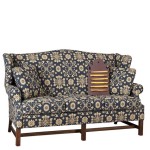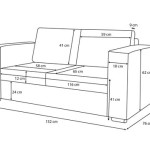Upholstering a Sofa: A Guide to Revitalizing Your Furniture
A sofa is a central piece of furniture in many homes. It serves as a place to relax, entertain guests, and enjoy family time. Over time, even the most well-loved sofas can show signs of wear and tear. The fabric may become faded, stained, or torn, the padding may flatten, and the overall appearance can deteriorate. Upholstering a sofa is an excellent way to revitalize this essential piece of furniture, restoring its beauty and extending its lifespan. Whether you choose to tackle the project yourself or hire a professional, understanding the process is key to achieving a successful outcome.
Benefits of Upholstering a Sofa
There are numerous benefits to upholstering a sofa. Firstly, it can significantly enhance its appearance. A fresh layer of fabric can transform an outdated sofa into a modern statement piece, complementing your home decor and elevating your living space. Secondly, it can address structural issues. If the padding is sagging or the frame is loose, reupholstering allows for necessary repairs and reinforcements to ensure long-term durability. Finally, it's an environmentally friendly choice. Rather than discarding a perfectly good sofa, reupholstering provides a sustainable alternative, allowing you to enjoy your furniture for many years to come.
The Upholstery Process
Upholstering a sofa is a multi-step process that involves stripping the existing fabric, preparing the frame, and applying new upholstery material. The first step involves removing the old fabric, which may be done by hand or using specialized tools. Once the fabric is removed, the frame is inspected for any damage or wear. Any necessary repairs are made, such as tightening joints or replacing broken springs. The next step involves preparing the frame for the new fabric. This may involve sanding, painting, or applying a sealant to ensure a smooth surface and prevent future wear. Once the frame is ready, the new upholstery fabric is cut to size and fitted onto the sofa. The fabric is then stapled or tacked to the frame, ensuring a tight and secure fit. The final step involves adding any decorative details, such as piping or buttons, to complete the upholstery process.
Key Considerations for Upholstering a Sofa
Before embarking on a sofa upholstery project, several key considerations are crucial for achieving a successful outcome. Firstly, material selection is paramount. A wide array of fabrics is available for upholstery, each with unique characteristics in terms of durability, comfort, and aesthetics. Factors to consider include the desired style, the level of traffic the sofa will receive, and personal preferences for texture and color. Secondly, the type of padding used can significantly impact the sofa's comfort and longevity. High-density foam provides excellent support and durability, while feather or down filling offers a softer feel. Thirdly, professional assistance may be essential. While some individuals possess the skills and tools for DIY upholstery, more complex projects may require the expertise of a professional upholsterer to ensure a high-quality finish and prevent costly mistakes. Lastly, budget is a significant factor. Upholstery costs can vary depending on factors such as the fabric chosen, the complexity of the project, and the level of professional involvement. Thorough research and planning can help you stay within your budget while achieving your desired results.

Do It Yourself Divas Diy Strip Fabric From A Couch And Reupholster

How To Easily Upholster A Sofa And Paint It Shabbyfufu Com

While They Snooze How To Reupholster A Tufted Couch

How To Easily Upholster A Sofa And Paint It Shabbyfufu Com

D I Y E S G N How To Re Upholster Furniture With Wood Parts

How To Reupholster A Couch Without Removing The Old Fabric Erfly House

How To Reupholster A Couch Without Removing The Old Fabric Erfly House

How To Upholster A Couch Or Sofa

Sofa Reupholstery In Atlanta Ga

Criteria To Consider While Re Upholstering Sofa Sets Homelane Blog








